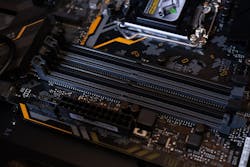AMD turns to chiplets as Moore's Law slows
SANTA CLARA, Calif., - For more than five decades, Moore’s Law has governed the pace of innovation in the semiconductor industry – driving evolution in the computing space from the early desktops and laptops to cloud computing and Internet of Things today, writes Mark Papermaster for TechRadar.com. Continue reading original article
The Intelligent Aerospace take:
October 10, 2019- Mil-aero computing has been taking a modular approach for a while now as the industry builds custom solutions based on building blocks that can be scaled up or down based on the needs of the customer or agency. That modular approach has been shrunk down to the processor level as AMD CTO Mark Papermaster writes that "If the design approach anticipates modular architecture, then portions of the design that are difficult to manufacture can be parsed into small die sizes. With small die, we get increased yield and increased number of chips per wafer, which will help further reduce manufacturing costs and increase production efficiency.
Related: Using multi-core processors effectively in aerospace and defense programs
Related: AMD expands low-power processor family to boost embedded computing, graphics performance
Related: It’s time: Avionics need to move to multicore processors
Jamie Whitney, Associate Editor
Intelligent Aerospace
